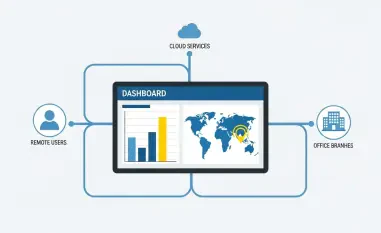Multiprotocol Label Switching (MPLS) has long been a staple in private wide-area network (WAN) connections, offering a method to establish shorter paths for data packets across networks using labels instead of traditional network addresses. However, as technology evolves, MPLS is increasingly seen as outdated. This article explores the reasons behind the decline of MPLS and presents cost-effective alternatives better suited for modern network needs.
The High Cost of MPLS
Expensive Infrastructure and Services
MPLS provides the security and reliability typical of private networks, but it comes at a significantly higher cost compared to standard broadband internet connections. The pricing of MPLS can vary widely due to location and volume of traffic, but monthly costs typically range between $300 and $600 per Mbps. In contrast, broadband options are substantially cheaper, ranging from $1.50 to $15 per Mbps. The need for specialized equipment and the involvement of managed service providers further increase the costs, making MPLS a less cost-effective choice for most organizations.
Organizations face daunting monthly expenses for MPLS, making it a high-entry solution. Broader geographic implementation often results in even steeper costs, especially within remote areas. The price discrepancy between MPLS and standard broadband can be staggering for firms with extensive networks. Companies must invest not only in the MPLS service but also in corresponding equipment for efficient functioning, raising the initial setup expense considerably. The overall Total Cost of Ownership (TCO) becomes prohibitive for many small to medium-sized enterprises, which may seek financially sustainable options for their networking requirements.
Additional Costs and Complexity
The implementation of MPLS is complex and generally requires manual configuration, which can be time-consuming and resource-intensive, particularly for geographically dispersed networks. This manual setup can take several months, presenting a significant burden on network administrators and complicating the management and scaling of the network. Additionally, the need for specialized equipment and managed service providers adds to the overall expense, making MPLS a less attractive option for many businesses.
Manual deployment involves intricate steps, including device configuration, routing and labeling, and integrating security measures. This could lead to delays and increased administrative overhead. Service providers often mandate long-term contracts tied to specific hardware, adding inflexibility to cost considerations. Enterprises committing to MPLS can encounter laborious, time-intensive deployments, regular maintenance, and necessary upgrades to counter burgeoning network demands. These aspects, cumulatively, drive up the cost while reducing available resources for other business operations. The persistent complexity and high expense factor curtail the appeal of MPLS for modern, dynamic businesses.
Security Concerns with MPLS
Vulnerabilities and Attack Surface
While MPLS is a private network, reducing the attack surface compared to public networks, it requires users to manage their security configurations. This can lead to vulnerabilities, as malicious actors could manipulate data packets to bypass MPLS routers. The need for additional security measures like firewalls and antivirus programs adds to the already complex configuration process, further complicating the network’s security management.
Despite isolation from public internet traffic, MPLS does not inherently encrypt data, often necessitating additional security controls to ensure data integrity and confidentiality. Cybercriminals can exploit weaknesses within the network, leveraging vulnerabilities when inter-network communication occurs or through unsecured endpoints. The reliance on manual intervention for security configurations heightens the risk of human error, potentially allowing unauthorized access. Businesses must continuously invest in sophisticated, multi-layered security environments to safeguard their networks, contributing to the increased complexity and cost.
Managing Security Configurations
The responsibility of managing security configurations falls on the users, which can be a daunting task. This can lead to potential vulnerabilities if not handled correctly. The need for additional security measures, such as firewalls and antivirus programs, adds to the complexity and cost of maintaining an MPLS network. As a result, businesses may find it challenging to ensure the security of their network, making MPLS a less appealing option.
MPLS users are tasked with crafting and maintaining a robust security posture, which requires significant expertise and dedicated resources. Security management involves monitoring traffic, implementing encryption, and ensuring compliance with continuously evolving policies and practices. For organizations lacking comprehensive cybersecurity capabilities, this can be particularly challenging, leading to potential oversights and breaches. This level of involvement and the continuous need for updates and patches to remediate vulnerabilities compound the management burden. Effective and secure MPLS utilization thus often exceeds the capacity of many businesses, driving them to consider more manageable alternatives.
Incompatibility with Modern Network Architectures
Cloud Computing Challenges
MPLS’s hub-and-spoke architecture and dedicated infrastructure make it incompatible with cloud computing, which relies on point-to-multipoint connections and edge computing frameworks. As businesses increasingly transition to cloud-based solutions, MPLS’s rigidity and incompatibility with the cloud make it a less viable option. The need for flexible and dynamic connectivity to support cloud applications further highlights the limitations of MPLS in modern network environments.
The rise of cloud services such as Infrastructure as a Service (IaaS) and Software as a Service (SaaS) requires networking solutions that are agile and scalable. MPLS’s static architecture constrains the network’s ability to efficiently distribute workloads across multiple cloud platforms. Organizations grappling with cloud integration find MPLS’s fixed pathways and manual scalability insufficient to meet fluctuating demands. These bottlenecks impede seamless cloud adoption and efficient resource allocation, underscoring the foundational inadequacies of MPLS within contemporary network strategies. Consequently, businesses moving towards digital transformation actively seek alternatives capable of dynamically supporting cloud-based activities.
Limited Control and Flexibility
Although MPLS theoretically provides control to the user, its complexity usually necessitates configuration and management by ISPs, thereby limiting the user’s practical control. Organizations must closely work with service providers to tailor the network to their needs, especially for enhanced security. This limited control and flexibility make MPLS less suitable for businesses that require agile and adaptable network solutions.
ISPs typically maintain the administrative control over MPLS setups, limiting direct user intervention and creating a dependency on managed services. For businesses, this not only restricts autonomy over their network but also complicates troubleshooting and real-time adjustments. The need to renegotiate or modify service agreements for varied network requirements can delay response times and reduce operational efficiency. In high-demand, rapidly evolving digital ecosystems, such inflexibility stifles innovation and performance optimization. Alternative networking solutions providing streamlined and user-centered control better align with the evolving demands and agility required by modern enterprises.
Alternatives to MPLS
Virtual Private Network (VPN)
VPN technology enables secure, encrypted connections over the internet, providing privacy and anonymity for online activities. It allows businesses to securely connect employees, partners, and staff to company resources, bypass bandwidth throttling and geographical restrictions, and enhance cybersecurity for remote and mobile users. VPNs offer lower cost and improved security with encryption standards, making them better suited for remote access and site-to-site connections.
VPNs have become increasingly popular due to their versatility and ease of implementation. Unlike MPLS, which requires extensive physical infrastructure, VPNs can be deployed using existing internet connections, significantly reducing costs. The encryption of data within VPN tunnels ensures secure communications, safeguarding sensitive information from potential cyber threats. Furthermore, VPNs facilitate seamless access from various locations, supporting the modern mobile workforce. This flexibility in deployment and usage positions VPNs as a more adaptable and cost-efficient alternative to MPLS for organizations seeking to strengthen their remote access capabilities.
Software-Defined Wide Area Network (SD-WAN)
SD-WAN uses software-defined principles to optimize WAN connectivity, offering cost-effective connections between headquarters, offices, and data centers. It provides full support for cloud systems and SaaS applications, centralized management, elastic traffic management, enhanced application-level visibility, and network control. SD-WAN also includes increased cybersecurity features like firewall protection and VoIP security, making it a more secure and flexible alternative to MPLS.
The adoption of SD-WAN technology signifies a shift towards smarter, more agile network management. By decoupling the control plane from the hardware, SD-WAN can dynamically route traffic based on current network conditions, ensuring optimal performance and efficiency. This promotes a more responsive network architecture capable of adapting to varying demands without downtime. Additionally, SD-WAN’s centralized management simplifies oversight and policy enforcement across a distributed network environment. Enhanced security measures integrated within SD-WAN, such as deep packet inspection and next-gen firewalls, provide robust protection against cyber threats, complementing its cost and operational advantages over traditional MPLS networks.
Hybrid SD-WAN
Combining traditional MPLS with SD-WAN, Hybrid SD-WAN enables bridging geographically dispersed WANs using varied connection types. It utilizes multiple connection methods to optimize traffic flow and reduce latency, offering cost-effective routing through internet connections and reducing WAN costs. Hybrid SD-WAN provides optimized path selection, policy implementation, and better traffic monitoring, integrating WAN services with reduced costs and improved management.
Hybrid SD-WAN provides businesses with the best attributes of both MPLS and SD-WAN, delivering a resilient, flexible network solution. By leveraging MPLS for critical applications requiring guaranteed performance and incorporating SD-WAN for cost-effective internet connectivity, organizations can optimize both reliability and expenses. The hybrid model ensures redundancy, enhancing network resilience and enabling seamless failover capabilities. This balanced approach accommodates scalability and future growth, adapting to technological advancements and evolving business requirements. Consequently, Hybrid SD-WAN represents a strategic option for enterprises looking to capitalize on existing MPLS investments while exploring innovative, more versatile networking benefits.
Secure Access Service Edge (SASE)
Multiprotocol Label Switching (MPLS) has been a cornerstone in private, wide-area network (WAN) links for many years. It provides a way to create shorter, more efficient routes for data packets by using labels instead of traditional network addresses. This method has been highly effective in enhancing the performance, reliability, and security of WAN connections. However, as technology advances, MPLS is increasingly viewed as an outdated option for modern networks.
There are several factors contributing to the decline of MPLS. Its static nature doesn’t align well with the dynamic requirements of today’s cloud-centric and highly mobile environments. Additionally, MPLS is generally more expensive than contemporary alternatives, which offer comparable, if not better, performance at a lower cost.
Moreover, the management of MPLS can be complex and labor-intensive, requiring specialized skills and resources. Emerging technologies, such as Software-Defined Wide Area Networks (SD-WAN), offer greater flexibility, simplified management, and improved cost efficiency. SD-WAN, for instance, leverages broadband internet connections and cloud services to provide secure and reliable network performance.
With the increased focus on cloud services, mobile workforces, and high-capacity data traffic, many organizations are transitioning from MPLS to new solutions that better meet their evolving needs. These alternatives are not only more cost-effective but also provide the agility required in today’s fast-paced technological landscape.













